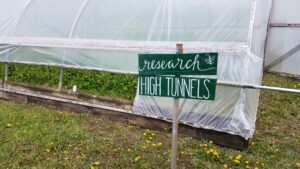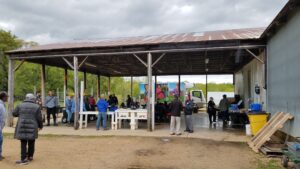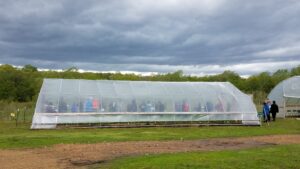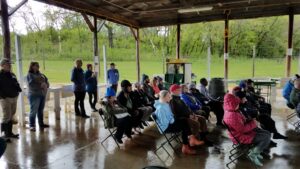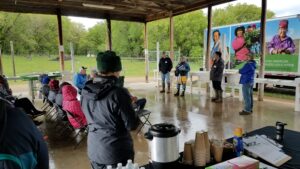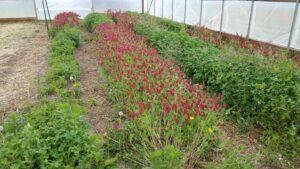Final report for ONC17-029
Project Information
With short growing seasons, utilizing high tunnels for season extension can be a sustainable strategy to increase farm profit and yield. However, despite proven merits, many immigrant farmers are slow to adopt the use of high tunnels. Language barriers, in addition to lack of time and access to resource networks makes adoption of high tunnels difficult and risky. Sustainability relies on equitable distribution of knowledge and resources and yet for many immigrant farmers, classroom settings, paper handouts, or information on a website are not viable means toward lasting changes in farm practices.
Through a hands-on peer-learning format that pairs ag professionals, university researchers, NRCS staff, and immigrant farm leaders, this project will establish replicable methods of effectively engaging immigrant farmers while also increasing the knowledge and adoption of financially and environmentally sustainable practices. This project will conduct hands-on field days and workshops at demonstration/research five sites (3 farms, 1 university and 1 non-profit food hub) to highlight the use of high tunnels and cover crops, document change in profit and showcase best practices to help encourage more immigrant farmers incorporate high tunnels and cover crops in their farm systems.
This project will:
-Develop farmer interview to capture high tunnel background history, management practices, lessons learned, benefits, advantages, disadvantages, and costs of high tunnels to inform a collection of case studies that farmers can use to decide if high tunnels are a good decision for their farm and if so, what kind, type, etc.
-Interview will ask about harvest times, yield amounts, labor inputs, total profit, soil health, etc. and will be compiled in a compendium of high-tunnel case studies gathered through the farmer interviews.
-Conduct cover crop demonstrations at five sites: The Good Acre, Holistic Health Farms, Hmong American Farming Association, Cala Farm
-Create high tunnel resources in Hmong and Spanish with input from farmers.
-Hold six hands-on field day workshops: Holistic Health Farms, Cala Farm, The Good Acre, Hmong American Farming Association (HAFA), Santa Rosa Farm, and Thao Gardens Farm.
-Partner with FSA and NRCS to individually sign up farmers for EQIP high tunnel funding.
-Develop replicable immigrant farm engagement strategies that involve peer-learning and hands-on workshops.
Cooperators
- (Researcher)
- (Educator and Researcher)
- (Educator and Researcher)
- (Researcher)
- (Researcher)
- (Educator and Researcher)
- (Educator)
- (Researcher)
- (Researcher)
- (Researcher)
- (Educator)
- (Educator)
- (Educator)
Research
The research to date is grouped into two categories:
- Cover Crop Research
- High Tunnel Farmer Interview
Cover Crop Research
Charlotte Thurston, University of Minnesota Applied Plant Science Graduate Student, is leading high tunnel cover crop research at all farm sites.
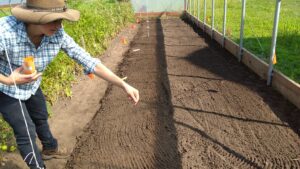
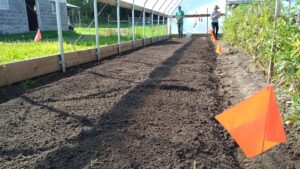
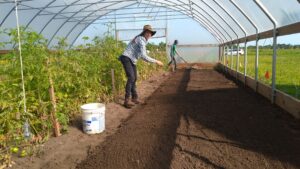
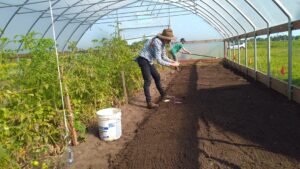
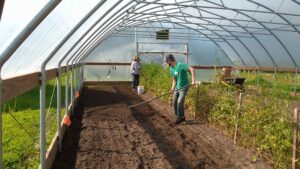
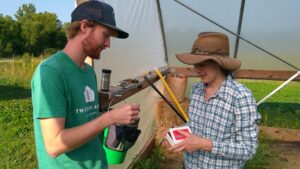

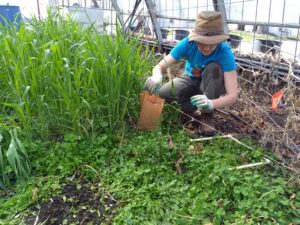
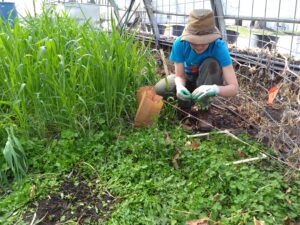

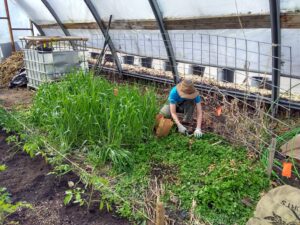
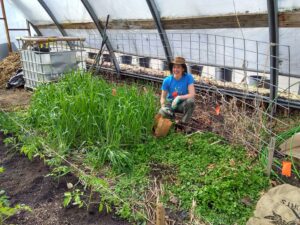
Main Goals for 2017- Implementing cover crop demonstrations/research trials in three high tunnels owned by participating farmers in Minnesota and Wisconsin. Major Activities to achieve goals:
Early Spring through Summer-
- Andrew Bernhardt and Charlotte Thurston met with farmers and visited farm sites to discuss current high tunnel and cover crop use and find spaces in on-farm tunnels for cover crop planting and demonstration.
Planting cover crops in high tunnels-
- August 28, 2017
- Seeded cover crops at Page and Flowers farm, St. Paul, MN with urban farmer Tim Page
- Seeded 3 stands of cover crops: red clover, a mix of hairy vetch, tillage radish, and winter rye, and a mix of winter pea and winter rye.
- Sampled soil to establish baseline soil nutrient levels and texture/quality.
- Installed temperature sensors to monitor high tunnel temperature fluctuations throughout the season.
- See attached map for visual of high tunnel space seeded
- August 30, 2017
- Seeded same 3 cover crop stands at HAFA farm in Rosemount, MN with the HAFA staff, main collaborators are Mark Zumwinkle and Janssen Hang.
- Sampled soil and installed sensors as at Page and Flowers farm.
- See attached map for visual of high tunnel space
- November 4, 2017
- Seeded Same three cover crop stands at Cala farm in Turtle Lake, WI with farmer Rodrigo Cala
- Late planting due to lack of high tunnel space earlier in the season, tomatoes and seedlings were the previous priority in these tunnel spaces.
- Sampled soil and installed sensors at at previous farm sites.
- Also put in low tunnel hoops and row-cover over all cover crops for added winter protection. It was late enough in the season by the time of this planting to perform this task.
- See attached map for visual of high tunnel space
- Home Demonstration Site, The Good Acre high tunnel, Oct. 19, 2017
- Seeded all three mixes in plots in one bed, then seeded red clover in bare patches in other beds, where cash crops have been harvested.
- The plastic cover will be removed from the tunnel over the winter, so no row cover will be installed at this site. Plants will experience unprotected (standard) winter field conditions. Cover crops will be available for demonstration purposes in the spring.
Stand Counts-
(3 weeks after planting cover crops, returned to see how many had germinated and were growing)
- Sept. 19 2017- Page and Flowers/Holistic Health Farms
- Placed two 0.5 m quadrats randomly in each cover crop plot. Counted number of cover crop plants (each species, if a mix) and number of weeds.
- Dug up two legume cover crop plants per plot, both had nodules (formed symbiotic relationship with rhizobia bacteria and were fixing nitrogen)
- Some patchy growth of cover crops due to necessary human traffic (harvest of remaining cash crops)
- Sept. 22 2017- HAFA
- Same sampling procedure with same quadrats
- Same procedure for checking for nodulation, all plants dug up had nodules
- Excellent stands here, dense growth of cover crops and uniform watering/germination
- Cala Farm- No stand counts because the cover crops were planted too late to really germinate this fall, most will germinate in the spring.
First Nodulation and Nitrogen Fixation Sampling-
- Nov. 3, 2017- Page and Flowers/Holistic Health Farms
- Sampled two legume cover crop plants and two reference plants per plot (to count nodules, dry biomass, and measure for fixed nitrogen)
- Installed low hoops and row-cover over cover crops, leaving a center gap where Tim Page has planted winter greens and established an aisle way
- Nov. 9, 2017- HAFA
- Same legume sampling procedure as at P and F.
- Installed low hoops and row cover over all cover crops.
- Cala Farm- No sampling because the cover crops were planted too late to germinate this fall, most will germinate in the spring.
Measurements:
- Nodules were counted in the lab for all sampled roots of legume plants.
- Plant shoots and roots were then dried and will be weighed and analyzed for nitrogen content in the winter/spring of 2018.
Future Planned Assessments and Activities for 2018:
- 1 Winter and 2 Spring samplings (same procedure as in Fall) will be performed to quantitatively assess nodulation and nitrogen plant content from legume plant samples for each cover crop trial/mix in Page and Flowers and HAFA tunnels. Cala farm will be sampled at the spring timepoints when the cover crops have begun to grow.
- Following the last spring nitrogen assessment, cover crops will be terminated by mowing and tilling with on-farm equipment and farmers will plant their spring/summer cash crops in the high tunnels.
High Tunnel Farmer Interviews
Instead of simply collecting data on sales and production/yield - we decided to expand this grant objective. We now plan on developing a high-tunnel interview template and conducting interviews with partner farmers that will compile insights on each farm's high tunnel that also includes profit and production information as well as info on high tunnel model built at each farm, management practices, lessons-learned, mistakes to avoid, and other insights that farmers can 'share' with other farmers that are interested in exploring high tunnels but are not sure and could use help in making an informed decision. These interviews collected into case studies will be made available in multiple languages.
Colin Jones, University of Minnesota Department of Horticulture Graduate Research Assistant, is leading the farmer high tunnel interviews and case study document. We have drafted the interview and are scheduling interviews in April 2018.
Spring Semester 2018 - Internship work plan
- February: Draft & review interview questions
- March: Finalize interview questions and schedule interviews
- April: Interview farmers
- May: Write and prepare collection of case studies
- Continue any necessary work on case studies into summer.
- Attend/volunteer at workshops/field days throughout 2018
Interview-Good-Acre-High-Tunnel-Immigrant-Farmer-Training-project
We successfully implemented cover crop trials at the three partner farm sites in addition to a trial at The Good Acre. During this project, we found:
- Legumes fix nitrogen in high tunnels throughout the winter season
- Active period of cover crop growth and nodulation extends late into the fall and begins early in the spring in high tunnels
- Temperature fluctuations in high tunnel environments may have delayed recovery of SNF and, in some species, biomass
- SNF differences between sites was likely due to high initial soil N content at Horst
- Slow spring recovery of SNF suggests farmers should delay termination to increase legume nitrogen contributions
However, there were challenges with this project's research:
- Farmer management practices may change or reduce the likelihood of legume SNF. For example: Low SNF at Cala may be partially attributed to late seeding and spring germination of plants at this site, but also to unexpectedly high soil N fertility. Baseline soil N was not excessive at Cala, but later in the season the farmer applied 54 kg/ha of N to the tunnel, which is higher than the recommended rate (Sustane Natural Fertilizer Inc. 2016), and this applied N likely reduced SNF.
- At all sites, there was high above-ground plant mortality for both crimson clover and Austrian winter pea, especially following the January sampling time-point, these species had lowest biomass in March. Having few surviving plants to sample may have affected our biomass and %Ndfa results for these species.
Summary: legume cover crops can successfully overwinter in high tunnels in the Upper Midwest in mono-cultures or mixes. Depending on high tunnel conditions, they can accumulate N through SNF through most of the winter and serve as a green manure for farmers in the spring.
- In terms of biomass, winter survival/persistence, and nodulation at replicated Mother sites, red clover and hairy vetch best over-wintered in our high tunnels, and are most likely to do well for Upper Midwest farmers hoping to add legume cover crops into their winter annual rotation.
- Monocultures of legumes and cover crop mixes produced similar biomass, and sites in different climatic zones had similar spring cover crop biomass as well. These are encouraging results for farmers in the Upper Midwest, they may see cover crop spring growth in high tunnels equal to that of growers in more southerly regions of the Midwest.
- Legumes were crowded out by strong competitors such as rye in species mixes, suggesting that higher legume seeding rates may be necessary for farmers interested in mixes for nitrogen provision.
- Cover crops suppressed weeds. Cover crop mixes that included rye suppressed more weeds than clover monocultures.
- Despite SNF reduction over the winter, results suggested that legumes fix nitrogen in high tunnels throughout the winter-annual season. Additionally, the active period of cover crop growth extended later into the fall and began earlier in the spring than for plants in the field. However, temperature fluctuations in high tunnel environments appeared to delay recovery of SNF in the spring.
- Slow spring recovery of SNF suggests farmers should wait to terminate winter annual cover crops as long as their rotations will allow to increase legume N contributions.
- Legumes had low %Ndfa in several tunnels with high initial soil nitrate levels. This may be beneficial in the high tunnel context, where in some cases, inputs may create high residual soil N as well as greater levels of phosphorus and salinity. In these cases, legumes planted will not initiate high levels of SNF. The high tunnel soil, which needs no additional N, can still benefit from the organic matter, soil biological activity, and moisture retention provided by a legume cover crop.
Further questions for future work
- More work on climate and temperature is needed. Why did colder sites have similar nodulation and spring biomass (kg ha-1) to warmer sites in this study? Does soil temperature matter more than air temperature for growth and survival in these legumes? A replicated study of soil temperature in tunnels as well as air temperature could help explain the influence of soil temperatures in high tunnels on over-wintering cover crops. Comparing temperatures inside and outside the tunnels using the same measurement equipment could also help elucidate differences between the tunnel environment and the adjacent field environment and how these differences effect plants in tunnels during the winter annual season.
- Recent breeding has produced specific winter-hardy selections of some of these cover crop legume species. Would more cold-tolerant cultivars of these legumes have greater biomass and SNF in high tunnels?
- Soil N was tested at the beginning of this experiment, but not after cover crop termination. How much N is actually being released into the soil from these cover crops? How much N is plant-available at later times in the season when farmers need it to support their cash crops?
- Which of these cover crop monocultures or mixes would farmers use again, considering the tradeoffs of using the different crops? (i.e. the drawbacks of difficulty with terminating cover crops and sacrificing some season extension time to grow them vs. the gains of soil fertility and weed suppression?)
TGA-SARE-Report_-HT-Cover-Crops_04-2019
Charlotte Thurston presented findings along with her graduate cover crop research at the 2019 MOSES conference.
Educational & Outreach Activities
Participation summary:
Planning is starting for the scheduled 2018 high tunnel workshops/demonstration days. We will hold 6 hands-on workshops utilizing the Skill-Share Model where we will ask farmers to bring knowledge, experience and questions to engage in peer-to-peer learning and conversations with fellow farmers. Non-project-partner farmers that attend can earn an honorarium to compensate them for their time and travel. We distributed high tunnel informational materials at the 2018 Emerging Farmers Conference along with a sign-up sheet for any farmer interested in learning more about high tunnel production at upcoming 2018 workshops. These names have been added to our farmer contact list and will be emailed info about planned workshops.
As a result of grant activities in planning farmer education programming, a natural partnership formed with Minnesota Food Association's Laura Heeden, programs manager for MFA's Farmer Education Program. Instead of planning parallel programming covering similar topics, we have started coordinating workshop planning which should have the result of increasing outreach and impact.
The first workshops is planned for Sunday April 29 from 2-4pm at Tim Page's urban high tunnel, Holistic Health Farms aka Page & Flowers farm. Tim and his partner Cherry will demonstrate how they get the most out of their high tunnel in the spring to maximize yield and profit. They will discuss which crops do best in early spring high tunnel production, such as leafy greens, bok choy, and kale and how to maintain soil health with cover crops. They will showcase their hydro/aquaponics set-up as well as their home-scale high tunnel design: mini-hoopers, a modular portable high tunnel for small plot sizes at about 8 feet wide and 6 feet tall that can easily accommodate a variety of bed sizes for home gardens and urban farms. Skillshare topics will include:
- Preparing your high tunnel for spring production
- Selecting and growing crops ideal for spring high tunnel production
- Deciding what size and type of high tunnel is best for you
- Using cover crops to maintain soil health in high tunnels
- Incorporating aquaponics & hydroponic systems in high tunnels
TGA-Spring-High-Tunnel-Field-Day
The second event will be held at Rodrigo Cala's farm on July 16, 2018. This field day will be coordinated in collaboration with Vivian Wauters highlighting her research at Rodrigo Cala's farm.
The third event will be held in August (specific date TBD) at The Good Acre and its high tunnels. The first half of the day will showcase the annual and perennial crops in our high tunnels as well as the new fertigation system that we will be installing this spring as part of a MDA Demonstration Grant. The second half of the day will be in The Good Acre's classroom, where we will partner with FSA and NRCS staff to help any farmer interested in applying for EQIP high tunnel funding do so in person before the August deadline.
The fourth, fifth and sixth events will take place in September at three partner farms: HAFA farm site, Thao Gardens Farm and Santa Rosa Farm. The agenda for these three farm demonstration field days will be identical and farmers will be encouraged to attend the one event that is most convenient for them.
The seventh event will take place in December at The Good Acre's classroom where we will once again partner with FSA and NRCS to do a hands-on sign up day for EQIP funding.
On Sunday April 29, 2018, we held our first high tunnel field day at Tim and Cherry's urban high tunnel farm in Saint Paul MN. The weather was still a bit chilly from a late cold spell and attendees appreciated the passive solar benefits of the hoophouse. Tim and Cherry facilitated an excellent round table discussion in which 24 farmers, educators, gardeners and urban ag advocates discussed the challenges and benefits to incorporating high tunnels into a farm operation and how high tunnels can help farmers diversify and achieve financial sustainability. SARE-Tim-Page-High-tunnel-Evaluation
Of the 24 attendees, 16 evaluations were submitted: 13 were farmers, 10 beginning farmers, 6 Minority/socially disadvantaged farmers and 2 educators. All 16 said that they would attend future events and recommend this to others. Of a 4 point likert scale with "a lot" being the highest, 13 said that the value of this event was a lot and 9 said that this workshop helped increased their knowledge of cover crops "a lot".
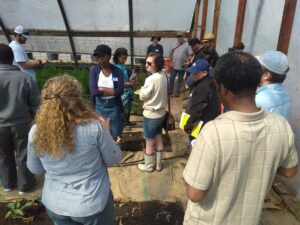
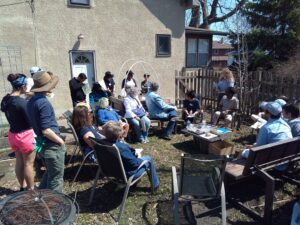
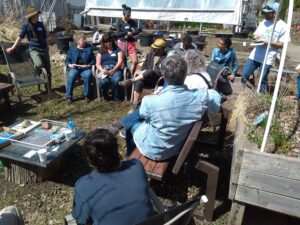
On July 16, we held a joint field day with UMN Grossman Lab at Rodrigo Cala's Farm. A head count of 29 attended of which 22 were farmers, 5 educators/TA providers, and approximately 14 beginning and approximately 6 minority/underserved farmers. Attendees learned about cover crop varieties; how and when to use different mixes/varieties, and how to identify cover crops in the field. Attendees grouped up with a researcher and did a mock walk through to identify cover crops, assess soil texture, and conduct some basic evaluation of cover crop in the research plots at Cala Farm. Rodrigo conducted a presentation about his farm operation and how high tunnels fit into his overall farm. He showcased a new hoophouse that was recently constructed and answered questions from participants. Of interest in attendance was a leader from the Minneapolis Parks and Recreation Board that brought three high school students to the workshop to learn about high tunnel farming. They were in the process of building a high tunnel at a Minneapolis park to start an operational Children's Garden. 12 evaluations were returned complete and out of those, the area that was reported gaining the most knowledge was learning about growing cover crops IN HIGH TUNNELS. It seems that this specific area is of interest and an area that people have questions about: how does managing cover crops in high tunnels differ from managing cover crops in open air fields?
SARE-Cala-High-tunnel-Evaluation

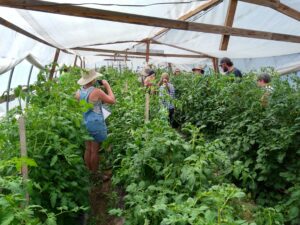
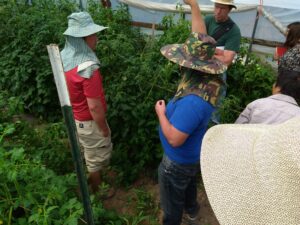
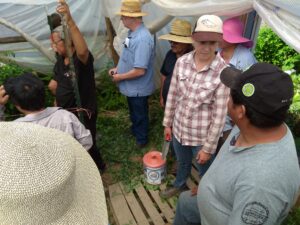
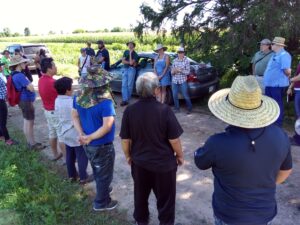
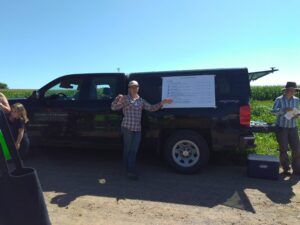
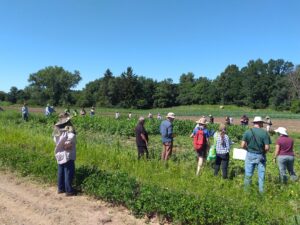
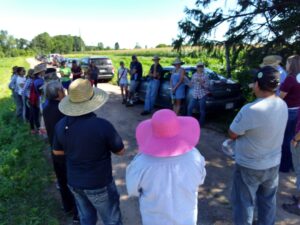
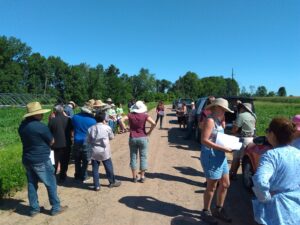
On August 9 2018, we participated in an Urban Ag Symposium Tour in partnership with the University of Minnesota Grossman Lab and Cornercopia Student Organic Farm. Approximately 50 people from across Minnesota and out of state participated in this tour. We showcased the high tunnels at The Good Acre, discussed the SARE grant project, the fertigation and sap analysis research being conducted in TGA hoophouse #2, and the cover crop research conducted by UMN Grossman Lab in TGA Hoophouse #3.
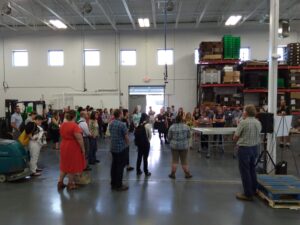
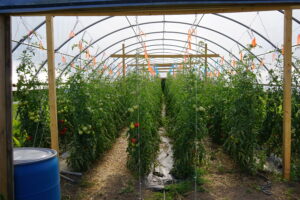

On September 25 2018, we held a high tunnel field day at Blia & Phua's farm in partnership with MOSES. Unfortunately, rain and cold deterred some registered people from attending, but we still had 26 individuals attend, including NRCS Soil Conservationist, Luke Breitenbach, to talk about EQIP brave the less than ideal weather. In particular it was great to be able to take full advantage of the high tunnel space and experience firsthand how the high tunnel can create microclimate environments. The majority of the attendees were seasoned white farmers (all but 2 one of which was a women beginning farmer of color) and it was particularly interesting to see Hmong farmers play the presenter role sharing their knowledge and experience of organic farming to a majority white growers. Blia, Phua and David (TGA Grower Support Specialist) led an excellent skillshare discussion circle in which everyone shared their high tunnel farming knowledge and many insights were gained and given from everyone in attendance.
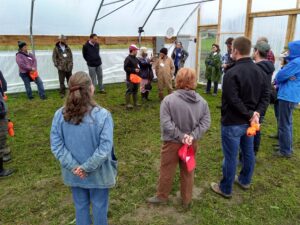
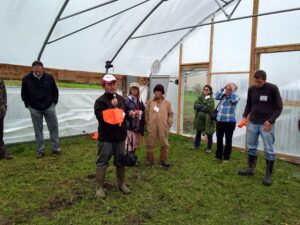
On March 6, 2019 - we held a high tunnel workshop at The Good Acre in partnership with the Sustainable Farming Association (SFA), University of Minnesota (UMN) and MFA Big River Farms beginning farmer program. Thirteen beginning farmers attended and learned about soil health, cover crops and high tunnel production. It is a little long, but here is a video recording of the full event: https://www.youtube.com/watch?v=NbCzbc4OrTc And despite the snow outside, underneath the row cover there are cover crops growing!
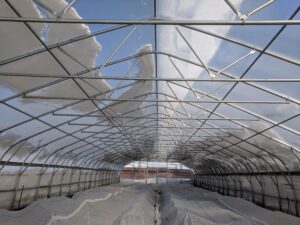
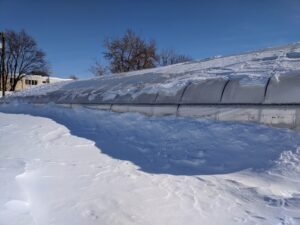
The fall workshop planned for HAFA did not happen due to scheduling conflicts/inaccessibility of presenters and the host farm, HAFA. This workshop has been rescheduled for mid-May and will cover the topics of interseeding cover crops with cash crops and accessing EQIP funding with NRCS grant partners. The date is TBD based on presenter availability, but we are looking at the end of May for the last workshop for this grant project.
On May 22, 2019 we held the project's final field day with the project's third partner farm, the Hmong American Farmers Association (HAFA), which was a fantastic and generous host. We had 44 people attend, of which 25 were farmers. We had NRCS give a presentation on the EQIP program and dedicate time to answering individual questions over lunch. HAFA was able to participate in talking about and explaining the EQIP experience to participants as they had just recently acquired and constructed three high tunnels via the NRCS EQIP program. Following this presentation, we moved into the high tunnels for a hands-on demonstration from UMN Grossman Lab with small-scale farm equipment that can be used in a high tunnel followed by a presentation on high tunnel production from UMN-Extension's Annie Klodd and Natalie Hoidal. The field day was well attended and many of the farmers (14 self-designated as "minority/socially-disadvantaged" on the evaluation) were able to use the interpretation headsets that I checked out from the Minnesota Food Association (MFA). Of the 25 returned evaluations, all 25 said that the field day was worth "a lot," the highest rating on the evaluation. Five evaluations wrote that: learning about and seeing cover crops in high tunnels was the highlight of the field day. Some quotes from the evaluations that stood out: "Got my gold nugget for the day -- solved a growing issue," and "It was very good to learn about the high tunnel uses and also the shared experience was wonderful."
TGA HAFA SARE UMN High Tunnel Field Day
Learning Outcomes
High Tunnel production
Cover Crops (and in particular cover crops in high tunnels)
Project Outcomes
Two years of high-tunnel cover crop trials and and high-tunnel production research at five sites (three on-farm sites, the University and The Good Acre) gathering data on changes in soil health, yield and profit, which will be showcased to 20 small-scale and immigrant farmers via field days and workshops. Long term increase in farm profitability and soil health through improved utilization of high tunnels and strong grower networks.
Hands-on peer-learning based curriculum developed with farmer input from 20 farmers attending six workshops. Impact: improved methods for connecting educators with immigrant growers allowing greater information exchange and improved growing practices.
Access to EQIP high tunnel funding with sixteen farmers signing up and ten new high tunnels purchased and built. Impact: Increased profitability for farmers able to access alternative season markers and increased number of high tunnels allow a greater variety of produce to be grown locally in northern climate.
New models of farmer-educator-researcher partnerships that foster mutual learning and project development. Permanent farmer-to-farmer peer-learning networks that sustain information sharing, collaboration, and on-farm learning.
